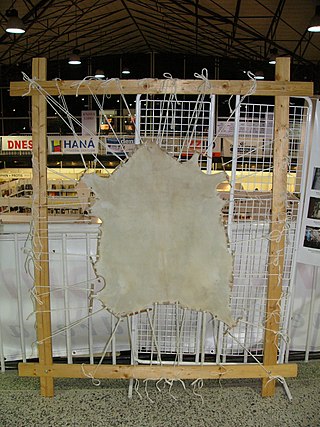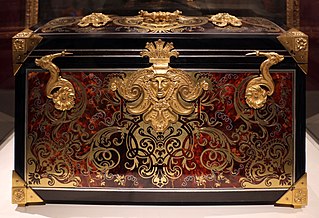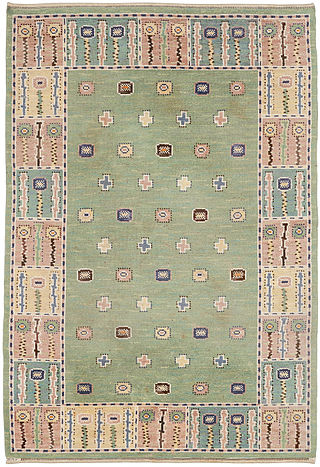Ganutell is a Maltese art form of making artificial flowers from wire, thread, and beads.
In his introduction to the book Ganutell by Maria Kerr, the Maltese scholar and historian Guido Lanfranco states that in Maltese eighteenth and nineteenth century history, one finds numerous references to ganutell which can be considered to be the Maltese art of making artistic flowers. The word ganutell is derived from the Italian cannotiglio and in fact this craft, which can also be considered to be an art, was "imported" to Malta during the eighteenth century from mainland Europe. The way the craft eventually evolved has made it distinctively Maltese.
This craft had its ups and downs and by the mid-twentieth century a considerable section of the Maltese population hardly knew of the existence of ganutell and only a few had mastered the various techniques of ganutell. The techniques had been passed on from generation to generation by word of mouth with little or no documentation until it seemed that this craft was destined to be forgotten.
Towards the end of the twentieth century, the Education Division offered evening courses in ganutell and the craft started on its way to recovery. Today it is known not only in Malta but interest has been shown from a number of European countries, North and South America and also in Japan.[ citation needed ]

Jewellery consists of decorative items worn for personal adornment, such as brooches, rings, necklaces, earrings, pendants, bracelets, and cufflinks. Jewellery may be attached to the body or the clothes. From a western perspective, the term is restricted to durable ornaments, excluding flowers for example. For many centuries metal such as gold often combined with gemstones, has been the normal material for jewellery, but other materials such as glass, shells and other plant materials may be used.

Parchment is a writing material made from specially prepared untanned skins of animals—primarily sheep, calves, and goats. It has been used as a writing medium for over two millennia. Vellum is a finer quality parchment made from the skins of young animals such as lambs and young calves.

Marquetry is the art and craft of applying pieces of veneer to a structure to form decorative patterns, designs. The technique may be applied to case furniture or even seat furniture, to decorative small objects with smooth, veneerable surfaces or to freestanding pictorial panels appreciated in their own right.

In European academic traditions, fine art is made primarily for aesthetics or creative expression, distinguishing it from decorative art or applied art, which also has to serve some practical function, such as pottery or most metalwork. In the aesthetic theories developed in the Italian Renaissance, the highest art was that which allowed the full expression and display of the artist's imagination, unrestricted by any of the practical considerations involved in, say, making and decorating a teapot. It was also considered important that making the artwork did not involve dividing the work between different individuals with specialized skills, as might be necessary with a piece of furniture, for example. Even within the fine arts, there was a hierarchy of genres based on the amount of creative imagination required, with history painting placed higher than still life.

Bobbin lace is a lace textile made by braiding and twisting lengths of thread, which are wound on bobbins to manage them. As the work progresses, the weaving is held in place with pins set in a lace pillow, the placement of the pins usually determined by a pattern or pricking pinned on the pillow.

The decorative arts are arts or crafts whose object is the design and manufacture of objects that are both beautiful and functional. It includes most of the arts making objects for the interiors of buildings, and interior design, but not usually architecture. ceramic art, metalwork, furniture, jewellery, fashion, various forms of the textile arts and glassware are major groupings.

Paper craft is a collection of crafts using paper or card as the primary artistic medium for the creation of two or three-dimensional objects. Paper and card stock lend themselves to a wide range of techniques and can be folded, curved, bent, cut, glued, molded, stitched, or layered. Papermaking by hand is also a paper craft.
Traditionalcrafts in Japan have a long tradition and history. Included in the category of traditional crafts are handicrafts produced by an individual or a group, as well as work produced by independent studio artists working with traditional craft materials and/or processes.
Painting – artwork in which paint or other medium has been applied to a surface, and in which area and composition are two primary considerations.

Phulkari refers to the folk embroidery of the Punjab. Although Phulkari means floral work, the designs include not only flowers but also cover motifs and geometrical shapes. The main characteristics of Phulkari embroidery are use of darn stitch on the wrong side of coarse cotton cloth with coloured silken thread. Punjabi women create innumerable alluring and interesting designs and patterns by their skilful manipulation of the darn stitch. According to Kehal (2009), a cloth where only a few flowers are embroidered is called a Phulkari. The other types are distinct varieties. The traditional varieties of Phulkaris are large items of cloth and include Chope, Tilpatr, Neelak and Bagh. Sometimes, the Bagh is given separate categorization of its own as on other varieties of a Phulkari, parts of the cloth is visible, whereas in a Bagh, the embroidery covers the entire garment so that the base cloth is not visible. Further, in contemporary modern designs, simple and sparsely embroidered dupattas, odhinis, and shawls, made for everyday use, are referred to as phulkaris, whereas clothing items that cover the entire body, made for special and ceremonial occasions such as weddings are called baghs. The Phulkari continues to be an integral part of Punjabi weddings to the present day.

Sprang is an ancient method of constructing fabric that has a natural elasticity. Its appearance is similar to netting, but unlike netting sprang is constructed entirely from warp threads. Archaeological evidence indicates that sprang predates knitting; the two needlework forms bear a visible resemblance and serve similar functions but require different production techniques.

Hairwork, or jewelry or artwork made of human hair, has appeared throughout the history of craft work, particularly to be used for private worship or mourning. From the Middle Ages through the early twentieth century, memorial hair jewelry remained common. Hair, considered to be a remnant off the person it was cut from, also has often played a part in myths and legends; in a Swedish book of proverbs, one can read that “rings and bracelets of hair increase love”. One example can be found in Denmark, at Rosensborg’s palace, which is a bracelet of precious metal with a simple braided lock of hair - a gift from King Christian IV (1577-1648) to his queen. Another example would be the rings commemorating the execution of King Charles I of England (1600-1649), which circulated among his faithful supporters. Other famous people who owned hair jewelry include Napoleon, Admiral Nelson, Queen Victoria and her large family, Christina Nilsson and Jenny Lind.

Mexican handcrafts and folk art is a complex collection of items made with various materials and intended for utilitarian, decorative or other purposes. Some of the items produced by hand in this country include ceramics, wall hangings, vases, furniture, textiles and much more. In Mexico, both crafts created for utilitarian purposes and folk art are collectively known as “artesanía” as both have a similar history and both are a valued part of Mexico's national identity. Mexico's artesanía tradition is a blend of indigenous and European techniques and designs. This blending, called “mestizo” was particularly emphasized by Mexico's political, intellectual and artistic elite in the early 20th century after the Mexican Revolution toppled Porfirio Díaz’s French-style and modernization-focused presidency. Today, Mexican artesanía is exported and is one of the reasons why tourists are attracted to the country. However, competition from manufactured products and imitations from countries like China have caused problems for Mexico’s artisans.

Glass art refers to individual works of art that are substantially or wholly made of glass. It ranges in size from monumental works and installation pieces to wall hangings and windows, to works of art made in studios and factories, including glass jewelry and tableware.

Ceramics in Mexico date back thousands of years before the Pre-Columbian period, when ceramic arts and pottery crafts developed with the first advanced civilizations and cultures of Mesoamerica. With one exception, pre-Hispanic wares were not glazed, but rather burnished and painted with colored fine clay slips. The potter's wheel was unknown as well; pieces were shaped by molding, coiling and other methods,

The visual arts are art forms such as painting, drawing, printmaking, sculpture, ceramics, photography, video, filmmaking, design, crafts, and architecture. Many artistic disciplines, such as performing arts, conceptual art, and textile arts, also involve aspects of the visual arts as well as arts of other types. Also included within the visual arts are the applied arts, such as industrial design, graphic design, fashion design, interior design, and decorative art.
Scandinavia has a long and proud tradition of rug-making on par with many of the regions of the world that are perhaps more immediately associated with the craft—regions such as China and Persia. Rugs have been handmade by craftspeople in the Scandinavian countries of Denmark, Finland, Norway, and Sweden for centuries, and have often played important cultural roles in each of these countries. Contemporary Scandinavian rugs—most especially Swedish rugs—are among the most sought after rugs in the world today, largely due to the contributions of designers like Marta Maas-Fjetterstrom. The story of Scandinavian rugs is a vital chapter in the cultural study of Scandinavia, as it reveals a great deal about the aesthetic and social conventions of that region.

Carpets and rugs have been handmade in Sweden for centuries, taking on many different forms and functions over the course of time. Rugs woven in the traditional Oriental manner, especially in the Ottoman Empire and points east, were originally brought to Sweden over trade routes as early as the early Middle Ages. In the centuries that followed, Swedish rug-makers often infused their works with themes and motifs traditionally found in Oriental rugs. Eventually, Swedish rug-makers would begin to use Oriental rug-making techniques, but themes and motifs more consistent with the artistic and cultural heritage of Sweden. By the early modern periods, rugs had long been an important avenue of art – especially folk art – in Swedish culture. By the beginning of the twentieth century, the craft was seen as being an important artistic and cultural practice throughout Sweden, and designers began to make rugs that had a broad international appeal. Swedish rugs from the mid-twentieth century remain among the most desirable and sought after in the rug world.

Mexican lacquerware is one of the country's oldest crafts, having independent origins from Asian lacquerware. In the pre-Hispanic period, a greasy substance from the aje larvae and/or oil from the chia seed were mixed with powdered minerals to create protective coatings and decorative designs. During this period, the process was almost always applied to dried gourds, especially to make the cups that Mesoamerican nobility drank chocolate from. After the Conquest, the Spanish had indigenous craftsmen apply the technique to European style furniture and other items, changing the decorative motifs and color schemes, but the process and materials remained mostly the same. In the 19th and 20th centuries, the craft waned during armed conflicts and returned, both times with changes to the decorative styles and especially in the 20th century, to production techniques. Today, workshops creating these works are limited to Olinalá, Temalacatzingo and Acapetlahuaya in the state of Guerrero, Uruapan and Pátzcuaro in Michoacán and Chiapa de Corzo in Chiapas.

Minakari or Meenakari is the process of painting and colouring the surfaces of metals and ceramic tiles through enameling, originating in Safavid Iran. It is practiced as an art form, and commercially produced mainly in Iran, India, Afghanistan, and Pakistan. Minakari art usually involves intricate designs, and is applied as a decorative feature to serving dishes, containers, vases, frames, display ornaments, and jewelry.